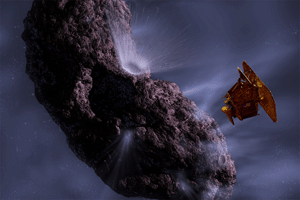“Deep Impact” Liaison Elizabeth Warner to be Interviewed by ECTV
2005 02 04
by Mitch Battros – ECTV
 I have been in contact with Elizabeth Warner of NASA’s “Deep Impact” mission. Elizabeth is the acting liaison between NASA and the amateur astronomy community. Elizabeth is also the co-curator for the “Deep Impact” website. I have been in contact with Elizabeth Warner of NASA’s “Deep Impact” mission. Elizabeth is the acting liaison between NASA and the amateur astronomy community. Elizabeth is also the co-curator for the “Deep Impact” website.
In an upcoming seminar on February 12th at the Southern Cross Astronomical Society in Miami, Florida, the description reads: “Wait till you see our fireworks! On 4 July 2005” It just so happens the Mayan elder ‘sacred fire ceremony’ in Guatemala is on this very same day of February 12th. I truly believe this is nothing more than a very interesting coincidence, but I know many of you will have other ideas.
As the Director of the University of Maryland Observatory, Elizabeth has developed excellent communication skills and is known for her ability to convey sometimes complex systems and formulas, in easy to understand terms so we can all grasp what is unfolding.
Look for our interview coming in March.
Nasa's Deep Impact mission, which will crash a projectile into Comet Tempel 1, has launched from Cape Canaveral. It will arrive at Tempel 1 in six months and eject a 372kg (820 lb) projectile into its path to blast a deep hole in its nucleus. The projectile will collide with the comet on 4 July - 24 hours after its release - traveling at 37,000km/h (23,000 mph).
It could punch a crater in the comet big enough to swallow Rome's Coliseum. The crater will reveal what lies beneath. The Deep Impact spacecraft lifted off January 12th from its Florida launch pad aboard a Boeing Delta II rocket. After achieving a parking orbit in space, the spacecraft was released from the second and third stages of the Delta rocket on its trajectory towards Tempel 1.
At the beginning of July, Deep Impact begins making final targeting maneuvers before releasing the "impactor" towards its quarry. The mothership will then capture images and gather data from a distance of 500km (300 miles) as the one-by-one-meter copper-fortified "impactor" shatters the surface of this cosmic body.
"We will be capturing the whole thing on the most powerful camera to fly in deep space," said Dr Mike A'Hearn, principal investigator on the mission.
"We know so little about the structure of commentary nuclei that we need exceptional equipment to ensure that we capture the event, whatever the details of the impact turn out to be."
The impactor will also carry a camera to take pictures as it hurtles toward Tempel 1, although it will probably be sandblasted in the final minute before hitting the comet's surface. The washing machine-sized projectile is composed of copper because this metal is not expected to appear in the natural chemical signature of the comet itself.
Deep Impact will provide a glimpse beneath the surface of a comet, where material and debris from the time of the Solar System's formation remain relatively unchanged. Comets are the undercooked leftovers that remained when a sprawling cloud of dust and gas condensed to form the Sun and planets 4.6 billion years ago.
Mission scientists are confident the project will answer basic questions about how the Solar System came to be, by offering a better look at the nature and composition of these frozen balls of ice and rock. It has been suggested that comets first delivered the basic building blocks of life - carbon-based molecules and water - to Earth.
The energy released by the collision is equivalent to that released by exploding 4.5 tons of TNT. It could create a hole in the comet ranging from the size of a two-bedroom house to the size of a ten-storey building. But the impact is definitely not expected to divert the path of Tempel 1.
Article From: newsletter@earthchangestv.com
Related: Deep Impact - Nasa
Mayan Elder Gives Surprising Prediction: Comet “Temple 1”

|
